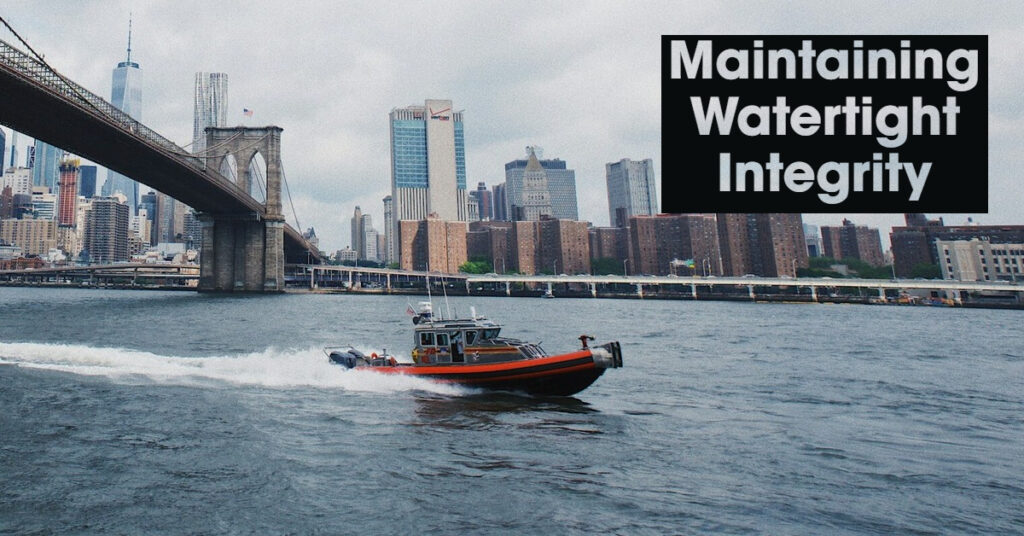It’s vital to ensure a vessel is seaworthy before it embarks on its journey. The average ship has various openings that are vulnerable to water ingress. Good watertight integrity on boat hatches is paramount to keeping the ship afloat and minimizing damage at all costs.

The Composition of a Boat Hatch
The hatch protects the boat’s storage and living spaces. Its parts and composition set it apart from regular entrances and ensure it keeps water out. For example, the frame should be secure to support the watertight well cap.
The boat hatch gasket is also a key component. This weatherstripping locks down the space beneath and keeps water out. Marine-grade hinges are essential to ensure liquid cannot travel through the crevices. Heavy-duty flat models can minimize spaces where it can pass through.
Marine hatch covers are the key piece, requiring high strength and corrosion resistance for good watertight integrity. Older vessels and the need for retrofitting are driving up demand and imploring better design in the industry. The market is expected to reach $289.56 million by 2032, with a CAGR of 7.6%.
Watertight vs. Waterproof
There is a difference between waterproofing and watertightness. While they seem interchangeable initially, there is a subtle difference that needs to be distinguished in water vessel production.
Watertight refers to impenetrability to water to avoid structural failure, including materials that allow contact with water but reduce damage. For example, the double-bottom tank in a boat is a watertight compartment that stores away ballast and provides stability. It is prone to leaks but is designed to hold them back.
Meanwhile, waterproofing refers to improving a material’s water resistance so it’s not affected by liquid. A good example is marine solar panels, which need to withstand splashes from the sea. Waterproofing’s primary goal is to protect the structure it’s applied to, while watertightness’s objective is to ensure the safety of who and what’s within it.
The Importance of Watertight Integrity
Some people may downplay the need for watertight integrity in a ship, believing water resistance is enough. However, it is integral for the boat, its cargo and its occupants throughout its course.
Water Mitigation
A boat is prone to water ingress, whether from ocean waves or rain storms. Most exterior components are geared to be waterproof, but the ship’s interiors are likely to be damaged if water gets in. Boat hatches with watertight integrity should keep inner and below-deck areas clear of liquid as much as possible.
Watertightness can preserve the comfort and aesthetics of the ship’s interior and minimize future maintenance. Uphauling and replacing boat decorations and materials is costly, so prevention is much better.
Buoyancy
Having water enter the boat is problematic. The increased weight can throw off the vessel’s balance, which heightens the chance of it sinking. Watertight compartments are key to maintaining the hull’s integrity and preventing that extra mass. Think of them as insurance for the ship’s buoyancy throughout its journey.
Equipment Protection
Watertight integrity in boat hatches can make or break the quality of cargo onboard. For example, storing 3 liters of freshwater for every person is recommended. If liquid gets into these units, they will be contaminated. The fluids would cause a malfunction in electronic devices.
Crew Safety
Watertight integrity is also paramount to maintaining crew safety. Water getting into the boat can cause it to sink. Many ships sail far from land, so they risk getting stranded in the middle of the sea and drowning. The liquid’s presence can also make surfaces much more slippery, which can cause accidents and injuries.

Gauging Watertight Integrity of Ship
Watertight integrity is dependent on the overall design and composition of the ship. Maximum impenetrability will require quality materials and an anchor locker. The exposure and sealants should be well-planned for proper support.
Material
The material is a defining factor in watertight hatches. These components should resist water, like marine acrylic or polycarbonate sheets. However, it’s enough for the design to be completely closed and compact to avoid pathways for the liquid to cross.
Supporting pieces like the hinges should also be made of quality material. Brass includes copper and zinc, which are relatively rust-resistant. Copper’s green patina serves as a protective layer of corrosion resistance. Zinc, while often inexpensive, is less durable on its own and can corrode when submerged in saltwater for long periods. This feature makes it ideal for freshwater fishing boats and other similar vessels.
Exposure
It’s best to secure hatches while maintaining accessibility. Depending on the size of the boat, move them closer to the center or by the aft of the ship. Some may need to be tied down if the weather and water conditions are rough.
Sealants
Most boat hatches will have extra sealant and systems to keep liquids out. For example, hatch covers are operated by a hydraulic unit. The pressure this distributes can hold down the hatches’ watertightness and keep the seal intact. Marine-grade sealants are also paramount to care for cracks or perishing material that could create gaps.
Emergency Procedures
Boats are subject to emergencies while at sea. Even experts aren’t sure when it will happen, so preparing emergency routines is paramount. For example, crews must close the hatches and shut off the valves if the ship is taking on water. These actions can stall water ingress enough to assess the situation and determine where the water is coming from.
It’s ideal to have emergency repair kits on board when hatches are overwhelmed and start leaking. Fast-curing caulk should be a simple fix to strengthen the gasket or cover up other holes allowing liquid to enter.
Conservation Efforts for Watertight Integrity
Investing in good watertightness can ensure the boat stays afloat while safeguarding everything and everyone on board. However, it’s important to practice vigilance. About 20 ships foundered in 2022, spotlighting the need for maintenance efforts.
Testing
Various hatch cover tests ensure watertight integrity. Boat owners can run these periodically while docked by spraying them with a hose a meter or two away from the covers. Watch out for leaks from the other side.
A high-tech option is to utilize an ultrasonic sensor. Test while docked and in motion to gauge the compression joints and pressure of the covering. The readings can reveal vulnerabilities within the hatch that could be reinforced with sealant.
Inspection
Boat hatches should be inspected even when they aren’t thoroughly tested. A visual assessment can give plenty of information about whether the materials are wearing out. Checking them now and then can notify boating enthusiasts of any immediate repairs and reinforcements needed to prevent problems.
Cleaning
Boat hatches should also be cleaned regularly, especially when exposed to saltwater, which can corrode materials. Warm, soapy water is best for these coverings. If there’s discoloration, mix bleach with water. Apply this diluted solution with a soft scrubbing sponge and rinse afterward. Perform this after every trip.
Secure Watertight Integrity
Watertightness on a ship is delicate and reliant on multiple factors and conditions. However, securing hatches is the difference between safety and danger on the sea. Avoid compromising these investments for a better sailing experience.
Frequently Asked Questions
Is Watertight Different From Waterproof?
Yes, watertight is different from waterproof. Waterproofing aims to protect the structure it’s applied to, while watertight integrity seeks to safeguard the people and objects within it.
How Important Is Watertight Integrity?
Watertight integrity is paramount to keep the boat afloat and in good condition. It can also influence the safety of equipment and people on board.
What Influences Watertight Integrity?
Material is a key factor that influences how good a ship’s watertight integrity is, as it needs to repel liquids without deteriorating. The placement of the hatch and sealants can also support watertightness.
What Helps to Maintain Watertight Integrity?
Boat hatches should undergo testing, inspection and cleaning. These procedures are integral to maintaining the vessel’s overall watertight integrity.
Are Watertight Boat Hatches Invincible?
Watertight boat hatches maintain watertight integrity but are still subject to leakage over time or when overwhelmed. Proper maintenance can prevent ships from foundering.
- The 15 Most Exciting New Ships of 2025 – January 6, 2025
- How Old Do You Have to Be to Drive a Boat? – November 12, 2024
- The Engineering Behind Ice-Class Vessels – September 20, 2024



